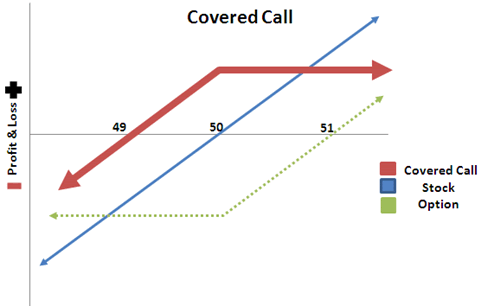Options Basics How to Sell Covered Calls
Post on: 27 Июль, 2015 No Comment

Think of this strategy as 'renting out' stocks for profit
Options Basics: How to Sell Covered Calls
Commonly touted as a gateway strategy, covered calls provide an alluring introduction into the options realm for stock traders looking to not only improve returns, but also attain a modicum of downside protection.
A covered call is sometimes referred to as a buy-write, covered-write or synthetic short put, often depending on the situation. Regardless of the lingo used, just remember that the trade involves buying (or owning) 100 shares of stock and selling one call option on that same stock. By shorting the call option, traders obligate themselves to sell the stock at the strike price. In exchange for bringing on this obligation, the option seller is compensated by receiving a premium paid by the option buyer.
Analogies for what the covered call is like abound, but perhaps one of the most insightful is viewing the strategy like a real estate investor would view a rental property.
You’re essentially renting out your stock as a means of producing passive cash flow. If you were to sell covered calls every month on a stock in your portfolio for $100 apiece, by year’s end you would have brought in $1,200 of income. Aside from cash flow, this monthly premium also acts as downside protection offsetting minor losses in the stock along the way. For example, if I sold a 100 strike call on a $95 stock for $3 of premium, I could afford for the stock to drop by as much as $3 before I actually lost any money on the position at expiration.
When comparing the risk graph of a stock position to that of a covered call, the advantages of the latter are easily seen by what I call the magic triangle .
Consider first the risk graph of a long stock position a straight diagonal line running from bottom left to top right, with a breakeven point resting at the current stock price.
How might the risk graph shift if we sold an at-the-money covered call? How can I see the aforementioned advantages of monthly income and downside protection?
Notice how the expiration risk graph shifts left and up to reveal a triangle (highlighted in orange). The extent of the shift comes down to the amount of premium received by the sale of the call option. The higher the premium, the more shift that occurs.
By selling a covered call, traders unlock this triangle and gain access to its goodies.
Of course, like all option strategies. covered calls don’t offer something for nothing. In exchange for acquiring monthly income and downside protection, the short call option cuts off your profit potential on the stock. It can be a bit disheartening when your stock rallies 20%, but due to a covered call you were only able to participate in 5% of the move. But, hey, that’s the nature of the beast and why it’s important to assess the maximum reward to ensure you’re satisfied with it before jumping into the trade.
Two of the dilemmas facing covered call sellers are which expiration month and which strike price to use.
Because of the higher rate of time decay, many traders look to sell short-term options such as weeklies or one-month options to maximize their gains over time. Such an approach, however, is more aggressive because the amount of premium received is usually smaller than selling two- or three-month options, and thus doesn’t provide much downside protection.
Choosing which strike price to sell should depend in large part on your stock outlook. If you’re more bullish and wish to be able to make some profit on the stock before having to sell it, consider selling a call option one or two strikes out-of-the-money. If you’re more neutral and primarily interested in acquiring protection, you could sell an at-the-money or even in-the-money strike call.
At the end of the day, it’s usually wise to run the numbers on a few different covered calls to determine which offers the right balance between risk and reward.
The following are basic formulas needed to properly evaluate the risk/reward characteristics of the covered call:
Cost Basis & Breakeven: Purchase price of stock premium of short call option
Maximum Reward. Short call strike price cost basis
Maximum Risk. Cost basis
Return on Investment. Maximum Reward/Cost Basis
Heres a hypothetical trade to give you an idea:
Suppose we bought Intel (INTC ) at $25.50 and sold the July 26 call for 50 cents. Our cost basis, as well as breakeven, would come out to $25. As long as INTC remains above $25 by July expiration, the trade will result in some type of profit.
The max reward is the call strike ($26) minus the cost basis ($25), or $1. Provided INTC rises above $26 by expiration, we will capture this max profit of $1 per share.
The maximum theoretical risk is $25 thats how much we would lose if INTC dropped to zero.
Finally, the return on investment is 4%, which is calculated by dividing the max reward ($1) by the cost basis ($25).
Like what you see? Sign up for our Young Investors e-letter and get practical investing advice delivered to your inbox every week!














